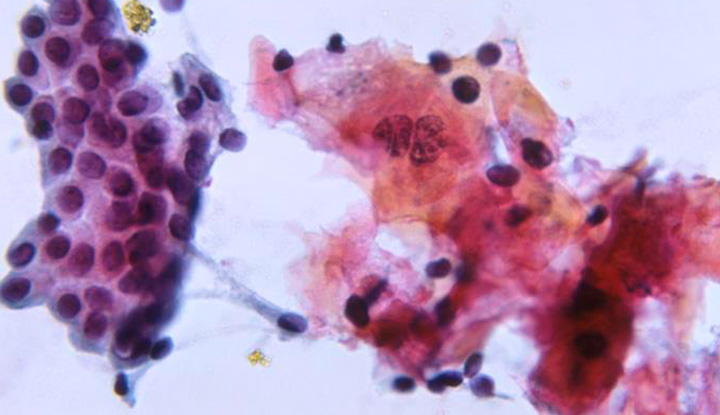Cytology (cytopathology) is a way to diagnose or screen for diseases with a small amount (sample) of tissue or body fluids. A pathologist examines cells in the sample to look for differences in their size and shape, or other changes. Cytology is most commonly used to screen for or diagnose cancer. It can also diagnose infections.
Advertisement
Cleveland Clinic is a non-profit academic medical center. Advertising on our site helps support our mission. We do not endorse non-Cleveland Clinic products or services. Policy

Cytology (also known as cytopathology) is a way to diagnose or screen for diseases by looking at cells under a microscope. A pathologist looks for changes in cells in a small sample of body fluid or tissue. These changes can indicate cancer or precancerous conditions. They can also look for infections, like bacteria, parasites, fungi and viruses.
Advertisement
Cleveland Clinic is a non-profit academic medical center. Advertising on our site helps support our mission. We do not endorse non-Cleveland Clinic products or services. Policy
Cytology is one of three main sections in anatomic pathology. It’s also called a branch, or subspecialty, of anatomic pathology. Anatomic pathology is the diagnostic study of diseases in tissues and various organ sites and their causes. Pathologists examine tissues and fluids from your body to diagnose disease.
A healthcare provider might order a cytology test to:
There are three types of cytology, based on the way your provider gets the sample: exfoliative, abrasive and intervention (or fine needle aspiration cytology).
When a pathologist examines cells that are naturally shed by your body, it’s called exfoliative cytology. These cells are found in body fluids or secretions. Samples your provider might use for exfoliative cytology include:
When a provider uses a procedure to dislodge and remove cells to be examined (like brushing or scraping), it’s called abrasive cytology. They can also use washing or lavage techniques, which means they use a solution to loosen cells and then collect them. Examples of abrasive cytology include:
Advertisement
Intervention cytology is when a provider collects the fluid sample using a small needle to pierce your skin. This is also called fine-needle aspiration (FNA) or aspiration cytology.
Providers use interventional cytology on lumps or masses they can feel from the outside, for instance:
Cytology allows a pathologist to see different parts of your cells. Your healthcare provider performs a Pap smear, endoscopy, fine-needle aspiration or other procedure to get a sample. They send the sample to a lab.
A cytopreparatory technologist stains the sample with colored dyes so the cytologist and/or the pathologist can see cells and their parts. They look for changes or abnormalities in the numbers of cells that can indicate diseases.
Most of the time, you don’t need to do anything specific to prepare for a cytology test. But every test is a little different, so ask your provider if there’s anything you need to do before your test.
Each cytology test is slightly different depending on the kind of cells providers are testing and whether the sample is tissue or fluid. In general, the steps of a cytology test include:
Advertisement
After they put together a report, the pathologist will send it to your healthcare provider. Your provider will go over the results with you and determine the next steps.
Complications from cytology tests are very rare. Some risks include infection and false-negative or false-positive results.
Compared to a tissue biopsy — another type of test that examines cells for diagnosis — a cytology test:
The type of results you get from a cytology test depends on what the test was for (for instance, screening or diagnosis) and what part of your body the sample was from.
Possible results include:
Advertisement
You may also see:
The time it takes to get the results of your cytology test depends on many factors, like what kind of cells the provider examined. Some routine cytology screenings could take as little as a day or two to get your results, while other tests could take one to two weeks.
Next steps depend on what you were being tested for and what the abnormal results mean. Your provider will let you know if you need additional testing or if they recommend treatment.
Talk to your healthcare provider if you have any questions about the procedure to collect the cytology sample or about the test results.
The goal of both cytology tests and biopsies is to diagnose or rule out diseases, but they have some differences. Cytology is the examination of individual cells or clusters of cells, so pathologists only need a very small sample to look at under a microscope for cytology tests.
Biopsies usually involve larger pieces of tissue than a cytology test needs, and a pathologist may examine several types of cells in a tissue sample taken from a biopsy. Biopsy procedures are also generally more invasive than cytology tests.
Advertisement
Cytology is a way for your provider to see what’s happening with your cells. Whether the test is part of a routine screening or you’re trying to get to the bottom of symptoms you’ve been having, waiting for the results can be stressful. It might help to remember that having as much information as possible gives you and your provider the best chance to make a plan for the future — including treatment, if necessary. Don’t hesitate to talk to your provider if you have concerns about the test or its results.
Cleveland Clinic’s primary care providers offer lifelong medical care. From sinus infections and high blood pressure to preventive screening, we’re here for you.

Last reviewed on 07/15/2025.
Learn more about the Health Library and our editorial process.